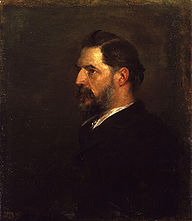- William Matthew Flinders Petrie
-
William Matthew Flinders Petrie 
Profesor Sir William Matthew Flinders PetrieNacimiento 3 de junio de 1853
Charlton, Londres, Reino Unido
Reino UnidoFallecimiento 28 de julio de 1942 (89 años)
Jerusalén, Plantilla:PALESTINANacionalidad Británico Campo Egiptología Conocido por Estela de Merenptah Sir William Matthew Flinders Petrie, FRS (Charlton, 3 de junio de 1853 – Jerusalén, 28 de julio de 1942) fue un importante egiptólogo británico, pionero en la utilización de un método sistemático en el estudio arqueológico. Ocupó la primera cátedra de Egiptología en el Reino Unido, y realizó excavaciones en muchos de los puntos arqueológicos más importantes de Egipto, como Naucratis, Tanis, Abidos y Amarna. Algunos consideran que su descubrimiento más famoso es la estela de Merenptah,[1] una opinión con la que el propio Petrie estaba de acuerdo.[2]
Contenido
Biografía
Flinders Petrie era nieto del capitán Matthew Flinders, explorador de las costas de Australia. Su familia se encargó de sus primeros estudios.
Los primeros pasos en arqueología los dio en monumentos prehistóricos de su país, incluyendo a Stonehenge. Visitó Egipto en 1880 inspirado por el astrónomo escocés Charles Piazzi Smyth (que buscaba en las dimensiones de la Gran Pirámide una verdad divina desconocida), aunque pronto desechó esas fantasías. En los años siguientes excavó en sitios como Abidos o Amarna. En noviembre de 1884 accedió a un puesto en el Egypt Exploration Found (actualmente Egypt Exploration Society), reemplazando a Édouard Naville.
Trabajó por su cuenta a partir de 1887, y estableció el Egyptian Research Account en 1894, vinculado a la British School of Archeology en Egipto. Volvió a colaborar con la Egypt Exploration Fund de 1896 a 1933.
De 1892 a 1933, Petrie fue el primer Edwards Professor of Egyptian Archaeology and Philology del University College de Londres, cátedra fundada por Amelia Edwards. En 1913 vendió al University College su colección personal de antigüedades egipcias, actualmente en el Petrie Museum of Egyptian Archaeology.
Desde 1926 sus estudios se centraron en Palestina, donde excavó varios lugares fronterizos entre Egipto y Canaán, como Tell el-Hesi, al que identificó, erróneamente, con la antigua Laquís.
Escribió más de mil libros, artículos y reseñas, y fundó Ancient Egypt. Su colección de antigüedades egipcias se encuentra en el Museo Petrie del University College de Londres.
Entre sus triunfos destacan el sistema de datación por secuencias (datación relativa a partir de los estilos de alfarería hallados en diferentes sitios), el salvamento de las tumbas reales arcaicas de Abidos, la escritura protosinaítica y las joyas de El-Lahun.
Examinó someramente la pirámide de Seila (cuarta dinastía), ubicada entre el gran oasis de El Fayum y la orilla occidental del Nilo.[3]
Sir Flinders Petrie murió el 28 de julio de 1942 en Jerusalén, y fue sepultado en el Cementerio Protestante.
Obras
Petrie publicó un total de 97 libros. Destacan los siguientes:
- Inductive Metrology: Or, the Recovery of Ancient Measures from the Monuments. Londres: Saunders, 1877.
- Stonehenge. Londres: Edward Stanford, 1880.
- Naukratis. Londres, 1886. Edición online
- Racial portraits : 190 photographs from Egyptian monuments. Londres, 1887.
- Two hieroglyphic papyri from Tanis. Londres: Trübner, 1889 (con F.L. Griffith)
- Ten years' digging in Egypt: 1881-91. Londres: Religious Tract Society, 1892.
- A History of Egypt, from the Earliest Kings to the XVIth Dynasty. 6 volúmenes. Londres, 1894. En colaboración con: Stanley Lane-Poole, Joseph Grafton Milne, Edwyn Robert Bevan, John Pentland Mahaffy.
- Tel el Amarna. Londres 1894.
- Egyptian Tales. Londres, 1895.
- Syria and Egypt from the Tel El Amarna letters. Londres: Methuen & Co., 1898.
- Religion and conscience in Ancient Egypt: lectures delivered at University College, London. Londres: Methuen & Co., 1898.
- Dendereh. Londres, 1900.
- Royal tombs of the first dynasty. Londres, 1900.
- Royal tombs of the earliest dynasties. Londres, 1901.
Referencias
Citas
Bibliografía
- Uphill, E.P. A Bibliography of Sir William Matthew Flinders Petrie (1853–1942), en: Journal of Near Eastern Studies, 1972. Vol. 31, pp. 356–379.
- Margaret S. Drower, Flinders Petrie: A Life in Archaeology, University of Wisconsin Press, 1995. ISBN 0-299-14624-3
- Margaret S. Drower, Letters from the Desert – the Correspondence of Flinders and Hilda Petrie, Aris & Philips, 2004. ISBN 0-85668-748-0
Enlaces externos
- The Petrie Museum of Egyptian Archaeology (en inglés).
- Artículo en el Barre Montpelier TimeArgus (en inglés).
- Libros de Petrie en el Proyecto Gutemberg (en inglés).
Categorías:- Arqueólogos del Reino Unido
- Egiptólogos del Reino Unido
- Nacidos en 1853
- Fallecidos en 1942
Wikimedia foundation. 2010.

